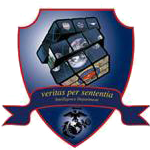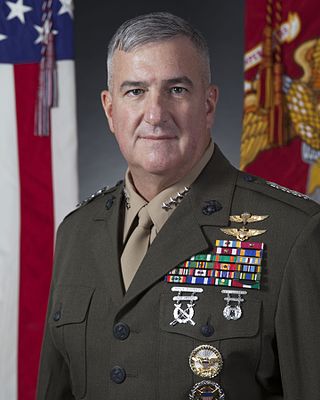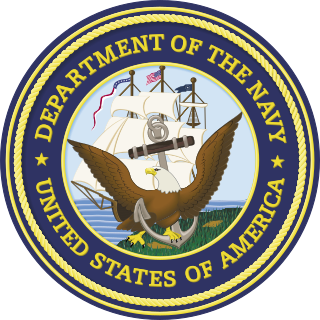The United States Armed Forces are the military forces of the United States. The armed forces consists of six service branches: the Army, Marine Corps, Navy, Air Force, Space Force, and Coast Guard. All six armed services are among the eight uniformed services of the United States.
The Fleet Marine Force Warfare Insignia, also known as the Fleet Marine Force badge or FMF pin, are three military badges of the United States Navy which are issued to those U.S. Navy officers and sailors who are trained and qualified to perform duties in support of the United States Marine Corps. There are currently three classes of the Fleet Marine Force pin, being that of enlisted, officer, and chaplain.

Air Force Materiel Command (AFMC) is a major command (MAJCOM) of the United States Air Force (USAF). AFMC was created on July 1, 1992, through the amalgamation of the former Air Force Logistics Command (AFLC) and the former Air Force Systems Command (AFSC).

The Naval Air Systems Command (NAVAIR) provides materiel support for aircraft and airborne weapon systems for the United States Navy. It is one of the Echelon II Navy systems commands (SYSCOM), and was established in 1966 as the successor to the Navy's Bureau of Naval Weapons.

Headquarters Marine Corps (HQMC) is a headquarters staff within the Department of the Navy which includes the offices of the Commandant of the Marine Corps, the Assistant Commandant of the Marine Corps and various staff functions. The function, composition, and general duties of HQMC are defined in Title 10 of the United States Code, Subtitle C, Part I, Chapter 506.

The Marine Corps Intelligence is the intelligence arm of the United States Marine Corps (USMC) and an element of the United States Intelligence Community. The Director of Intelligence supervises the Intelligence Department of HQMC and is responsible for policy, plans, programming, budgets, and staff supervision of Intelligence and supporting activities within the U.S. Marine Corps as well as supervising the Marine Corps Intelligence Activity (MCIA). The Department supports the Commandant of the Marine Corps (CMC) in his role as a member of the Joint Chiefs of Staff (JCS), represents the service in Joint and Intelligence Community matters, and exercises supervision over the MCIA.

The Marine Corps Logistics Command (MARCORLOGCOM) is a major command of the United States Marine Corps responsible for providing support for fielded weapons systems, support services and supplies.
The Department Of the Navy Acquisition Intern Program is a civilian professional hiring program. The Naval Acquisition Career Center manages several hundred interns at any given time.

The Operational Test and Evaluation Force (OPTEVFOR) is an independent and objective agency within the United States Navy for the operational testing and evaluation (OT&E) of naval aviation, surface warfare, submarine warfare, C4I, cryptologic, and space systems in support Navy and Department of Defense acquisition programs.


The United States Army Sustainment University is the Army's center of sustainment training for Department of Defense military and civilian personnel pursuing Professional Military Education (PME) and other associated training in military logistics and sustainment. The Army Sustainment University (ASU) has two campuses. The Somervell Campus at Fort Gregg-Adams, Virginia, delivers sustainment leader education for Quartermaster, Ordnance, and Transportation Soldiers and civilians. The Adams Campus at Fort Jackson, South Carolina, includes the Soldier Support Institute, which delivers Adjutant General and Financial Management leader education. ASU is a subordinate command to the United States Army Combined Arms Support Command, and is located at Fort Gregg-Adams, Virginia. The current President of Army Sustainment University is Ms. Sydney A. Smith, Senior Executive Service.
The systems commands, abbreviated as SysCom or SYSCOM, are the materiel agencies of the United States Department of the Navy, responsible for the design, construction, and maintenance of military systems such as ships, aircraft, facilities, and weapons. The systems commands replaced the Navy bureau system in 1966 and report to the Assistant Secretary of the Navy for Research, Development and Acquisition. The current Navy systems commands are:
The Deputy Assistant Secretary of the Navy for Expeditionary Programs and Logistics Management is a civilian office of the United States Department of the Navy. The DASN (ELM) reports to the Assistant Secretary of the Navy for Research, Development and Acquisition, and serves as the principal adviser to the assistant secretary involving three areas: expeditionary and ground programs; rapid acquisition and urgent needs; and logistics and sustainability.

The Assistant Secretary of the Navy (Research, Development and Acquisition) (abbreviated ASN (RDA)) is a civilian office of the United States Department of the Navy. The Assistant Secretary of the Navy (Research, Development and Acquisition) requires Senate confirmation, and engages in duties as directed by the United States Secretary of the Navy.

Glenn Michael Walters is a retired United States Marine Corps General, who served as the 34th Assistant Commandant of the Marine Corps from 2016 to 2018. He was appointed as the 20th President of his alma mater, The Citadel, on April 12, 2018.

David Smith is a Republican member of the Florida Legislature representing the state's 38th House district.

The United States Army Acquisition Corps (AAC) is the officer / NCO corps of the United States Army Acquisition Workforce (AAW), a branch which includes civilians, officers, and NCOs. The Acquisition Corps is composed of army officers who serve in acquisition, a specialized form of product development, fielding, and support and Noncommissioned Officers who specialize in Contracting, Level I Program Management and Purchasing. These officers begin their careers in the other branches of the army for eight years, after which they may elect the Acquisition branch as their career as assistant program managers (APMs), program managers (PMs), and program executive officers (PEOs). The Noncommissioned Officers (NCOs) are reclassified in the Army Acquisition NCO Corps after serving 7-10 years in their respective enlisted career management fields, and serve primarily in the Army Acquisition Career Management Field - 51 and (MOS) 51C. 4% percentage of the Army Acquisition Officers serve among the 40,000 members of the army acquisition workforce, 6% in MOS 51C - Acquisition, Logistics and Technology Contracting Noncommissioned Officer, and the remainder 90% percentage consist largely of Department of the Army civilians.
Human Systems Integration (HSI) is an interdisciplinary managerial and technical approach to developing and sustaining systems which focuses on the interfaces between humans and modern technical systems. The objective of HSI is to provide equal weight to human, hardware, and software elements of system design throughout systems engineering and lifecycle logistics management activities across the lifecycle of a system. The end goal of HSI is to optimize total system performance and minimize total ownership costs. The field of HSI integrates work from multiple human centered domains of study include training, manpower, personnel, human factors engineering, safety, occupational health, survivability and habitability.














